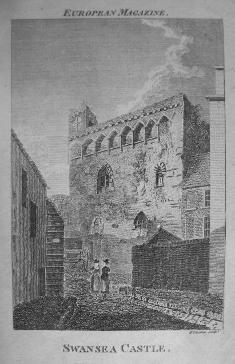Life after the Lords of Gower
Things were much quieter once the Marcher Lords and Princes of Deheubarth stopped fighting, although gunports were added to the tower around the time of the Wars of the Roses (1455-87), when Lord Herbert of Raglan held Gower.


On the first known sketch of the castle, created by Francis Place in 1678, we find that the square tower was used as a glass works producing wine bottles, samples of which have been found during excavations here. In 1700 a town hall was built in the castle courtyard. Where the great and the good had once been entertained in the Great Hall, the poorest of Swansea's inhabitants were later incarcerated; in 1750 the Great Hall became the town's "poor house" (workhouse). A market filled the courtyard by the 1770s. Other buildings cosied up to the castle walls along Castle Lane, whilst on the site of the old castle fine Georgian residences such as Worcester House, with its bay windows and gardens looking out over the river, were built.
